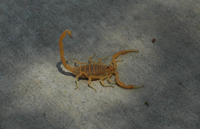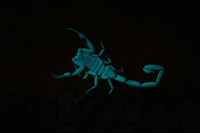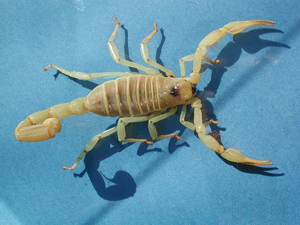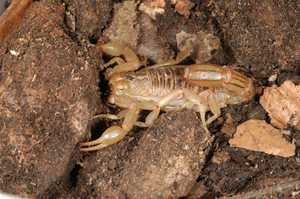



Scorpions
Arizona has from 40-60 different species of scorpions (Gouge et al.). They are active at night and hide out in rocks, wood piles, under tree bark or in burrows during the day. Man made materials left sitting outside like boots, piles of clothes, and sleeping bags can offer shelter too! After birth, baby scorpions crawl up onto their mother's back and live there for up to several weeks. A female scorpion can give birth to 25-35 young, so it can get crowded up there! Most scorpions will glow in the dark when exposed to a ultraviolet light, or blacklight (see the photo below on the right).Arizona Bark Scorpion (Centruroides sculpturatus)


Name:Arizona Bark Scorpion
Size: up to 3.14 inches. They only need 1/16 of an inch of headroom to find their way into your home or outbuildings.
Habitat: Rocks, piles of bark or woodpiles. Crevices where they can hide.
Prey: Small insects, crickets and roaches.
Danger:
The Arizona Bark Scorpion is the most venomous scorpion in North America. A sting from a Bark scorpion is painful and potent, and because the venom is a neurotoxin, temporary paralysis or disfuntion of the area that is stung can occur. Temporary loss of breath and the sensation of electrical jolts also occur. Symptoms typically last between 24 and 72 hours. While fatalities are rare in the US, small animals, small children and adults in poor health are particularly vulnerable to these stings.
Giant Desert Hairy Scorpion (Hadrurus arizonensis)

Name: Giant Desert Hairy Scorpion
Size: The largest scorpion in Arizona. It can reach 5.6-6.0 inches in length.
Habitat: It is often found in and around washes where it digs burrows that can reach up to 2.5 m in depth.
Prey: Other scorpions, large insects, spiders and small lizards, snakes and other vertebrates.
Danger: A sting from a Giant Desert Hairy Scorpion is not very dangerous unless an allergic reaction occurs. It can be compared to a honeybee's sting.
Striped-Tailed Scorpion (Hoffmannius spinigerus)

Name: Striped-Tailed Scorpion, or devil scorpion
Size: Up to 2.8 inches in length. You can tell this scorpion apart from the Arizona Bark Scorpion by the brown/tan stripes on the back of its tail and its relatively thicker tail.
Habitat: It can be found under objects and digs burrows.
Prey: Small invertebrates.
Danger: Its venom is not considered dangerous.
Some Links to Information about Arizona Scorpions:
- Cooperative Extension, University of Arizona.
- Arizona-Sonora Desert Museum
Photo Credits:
Arizona Bark Scorpion - Brian Basgen (CC Attribution-ShareAlike 3.0 License), Arizona Bark Scorpion under UV light - Bryce Alexander (Public Domain), Desert Hairy Scorpion - Fritz Geller-Grimm (CC Attribution-ShareAlike 2.5 License), Stripe Tailed Scorpion - Acrocynus (GNU Free Documentation License).The information on this page was taken from Wikipedia under a GNU Free Documentation License unless otherwise noted.









